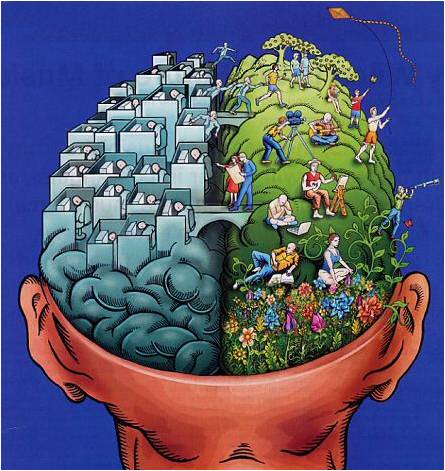One of the most controversial research studies concern the way that we humans think; how our brain actually works. There have been some interesting theories put forward about the functions of both sides of our brain. Concepts such as ‘Left Brain Thinking’ and ‘Right Brain Reasoning’ abound and we have been told that women are able to multi task because they have a more active corpus callosum [those bridges which connect the two sides] with 10% more neuron fibres. The level of connection between the left and right sides of the brain is said to have a large impact on the mental processes.
The theories about the functioning of the brain are indeed fascinating and Nobel Prize winner, Dr Roger Sperry, working with patients with surgically separated corpus callosum, summarised his findings thus “Everything we have seen indicates that the surgery has left these people with two separate minds. That is, two separate spheres of consciousness”
This seems to indicate that we have two distinct sides to our brain which we access while thinking, reasoning and communicating. Such an idea is, as I said, controversial and there are as many critics of this conclusion as there are supporters. To complicate it even further, the work of Dr V.S.Ramachandran PhD has opened up some new ideas on how the brain processes information and how some thinking crosses over between traditional left and right brain roles.
While it is a fabulous topic for a dinner party discussion or the breakfast table ponderings, there is, I feel, a trap that we can easily fall into if we take this information as a given and use it to limit our own types of thinking, or at least, our attitude to the way we reason.
‘I don’t have a creative bone in my body! I’m a left brain thinker!’ – the left brain traditionally being associated with analytical and sequential reasoning. ‘Don’t ask me to be rational – I love exploring my right brain creativity’ – the right brain being associated with imagination and interpersonal skills.
So we get, ‘ I’m not good with people – I must be left brain dominant’ or ‘I’m no good with figures, I tend to right brain thinking’ which are really only excuses we make so we don’t have to make the effort.
More recent research indicates that we can also be culturally and socially influenced in the way we traditional think and that nationalities have even been characterised by this – the logical thinking Germans, the emotional Italians for instance – and of course there’s the well known fact that we can change the way that we think to create a new reality by changing our personal voice of doom into a positive personal cheer squad – The power of positive thinking.
So what does all this mean for us average, confused humans just trying to exist in the world today? Well there are some tentative conclusions that we might like to consider:
• Our thinking process can be an outcome of the way in which are socialised and the culture in which we have been raised, and we can choose to change that.
• In reality we already use both sides of the brain when analysing problems and considering solutions, and we do that [dare I say it] without thinking about it.
• Each of us can usually access both sides of the brain, but we may not be used to it and might have to learn how to do it
It is true that some of us are more inclined to use one side of brain more than the other, but that should not mean we are incapable of using the other side, because that of course is a foolish idea. However, there may be a question of whether our education system can influence our preference.
“There appears to be two modes of thinking, verbal and non verbal, represented rather separately in left and right hemispheres respectively and that our education system as well as science in general, tends to neglect the nonverbal form of intellect. What it comes down to is that modern society discriminates against the right hemisphere.” Dr Roger Sperry (1971)
Rational thinking has become prized, while creative thinking is often dismissed as being unrealistic. Science, we are told, has led the way in logic and reason – but those that make such a claim forget that one of the greatest scientists of all, Albert Einstein, told us that “Imagination is more important than knowledge.” In fact the greatest scientific discoveries come from creative thinking. Newton’s connection of the falling apple with the earth’s gravitational field came straight out of the right side of his brain!!
Like all changes in our life, changing our mind may not be easy, but making a decision to try to develop a different way of looking at things is at least a start and it doesn’t really matter which side of the brain is used in making that decision. Let’s stop making excuses for lazy thinking and try for a bit of whole brain thinking for once.
Michele @ Trischel
Some references used for this article:
• V.S.Ramachandran & Sandra Blakeslee, Phantoms in the Brain, Probing the Mysteries of the Human Mind, William Morrow, New York, 1998
• R.W. Sperry, Brain bisection and consciousness, in How the Self Controls Its Brain, ed C. Eccles. Springer-Verlag, New York, 1966.
• R. Carter, Mapping the Mind, Phoenix, London, 2004, Originally Weidenfeld and Nicolson, 1998.


